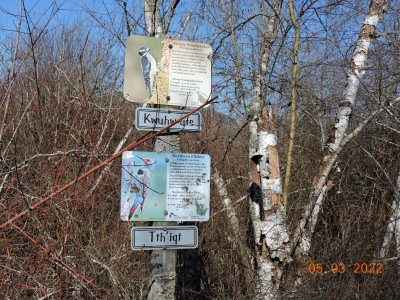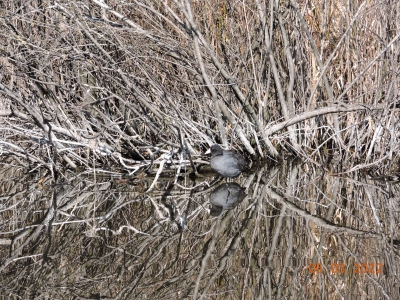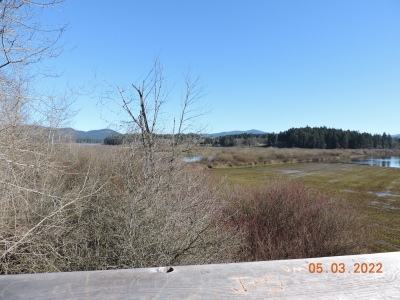North in the Spring # 20:
Cowichan Valley Part 1. by John Neville  Duncan is a growing city in the Cowichan Valley on Vancouver Island. Travelling south on Hwy #1 we turned east onto Drinkwater Rd. just before the Forestry Discovery Center to reach Somenos Lake. This is an important lake for salmon, waterfowl and plants. Salmon spawn in Averill, Bings and Richards feeder creeks. During summer droughts, when the lake is low, warm and short of oxygen, salmon fry return to the cooler creeks. Among the waterfowl, there were many Common Merganser, Mallard and a pair of American Coot. Nearby in a field we counted 50 grazing Trumpeter Swans. These iconic birds need to eat 4.5 kg of grass every day! They are the heaviest flying birds in North America. After recovering from near extinction 100 years ago, at Lonesome Lake, many of them now winter on the east coast of Vancouver Island. In January 2022 more than 400 were counted in the Cowichan Valley. Their bugalling calls are a delight to the hear!
Duncan is a growing city in the Cowichan Valley on Vancouver Island. Travelling south on Hwy #1 we turned east onto Drinkwater Rd. just before the Forestry Discovery Center to reach Somenos Lake. This is an important lake for salmon, waterfowl and plants. Salmon spawn in Averill, Bings and Richards feeder creeks. During summer droughts, when the lake is low, warm and short of oxygen, salmon fry return to the cooler creeks. Among the waterfowl, there were many Common Merganser, Mallard and a pair of American Coot. Nearby in a field we counted 50 grazing Trumpeter Swans. These iconic birds need to eat 4.5 kg of grass every day! They are the heaviest flying birds in North America. After recovering from near extinction 100 years ago, at Lonesome Lake, many of them now winter on the east coast of Vancouver Island. In January 2022 more than 400 were counted in the Cowichan Valley. Their bugalling calls are a delight to the hear!
The lake outflows into Somenos Marsh. After returning to Highway # l, we travelled another 1.7 km south, and turned east again, into Somenos Marsh. Because the highway is divided, it is simpler to reach these two locations from the south ( from Victoria). If you want to know more about nature and why human beings have lived there, since before the pyramids were built, this is a special place to visit. At the beginning of the trail, there is a Talking Circle where elders give presentations to naturalists and school groups about the area. Some of the food bearing plants in the marsh are: Red Elderberry, Blue Elderberry, Indian Plum, Mock-orange, Flowering Current, Sitka Mountain Ash and Pacific Crab apple. On the far side of the marsh is a remnant Garry Oak meadow where Great Camas were harvested. The camas bulb needed to be boiled for 24 hr before eating, but 'they make you very farty'.  Walking along the boardwalk we learnt a few Halkomelem words of the 7 Cowichan tribes. Some bird names were as follows: Spotted Towhee Sxeesh, Downy Woodpecker Kwuhw-ut, Northern Flicker Tth'iqt, Cedar Waxwing Sqw,ulesh and common Raven is Spaal'. The apostrophe at the end of a word indicates a guttural sound in the back of the throat. From the boardwalk we spotted Northern Shoveller, Eurasian Wigeon and several Canada Geese. A pair of Bald Eagles allowed us to walk right under their tree!
Walking along the boardwalk we learnt a few Halkomelem words of the 7 Cowichan tribes. Some bird names were as follows: Spotted Towhee Sxeesh, Downy Woodpecker Kwuhw-ut, Northern Flicker Tth'iqt, Cedar Waxwing Sqw,ulesh and common Raven is Spaal'. The apostrophe at the end of a word indicates a guttural sound in the back of the throat. From the boardwalk we spotted Northern Shoveller, Eurasian Wigeon and several Canada Geese. A pair of Bald Eagles allowed us to walk right under their tree!
Unmodified wetlands provide some of the following benefits: natural flood control, water purification, carbon storage, rich biodiversity, recreation and tourism. Human development has compromised many of these functions, such as the extensive diking in the Cowichan Valley. The water from this marsh consolidates into Somenos Creek, flowing south into the Cowichan River. This area along the Iake, marsh, creek and river was the extensive site of the villages of Cowichan Tribes-one named Somenos. The wetlands were the grocery store of fish, plants, birds, deer and elk which sustained the people for millennia. 
 
|